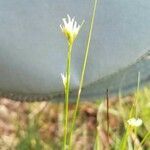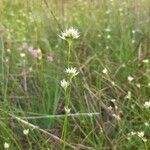Plants perennial, densely cespitose, 6–75 cm; rhizomes mostly absent. Culms erect to curved, leafy, obscurely trigonous to nearly terete, few ribbed, slender. Principal leaves mostly overtopped by culm; blades narrowly linear to filiform, proximally flat, 0.5–1.5 mm, apex tapering, trigonous. Inflorescences: clusters 1 or 2–3, then widely spaced, narrowly turbinate to hemispheric, 1.5–2.5 cm wide; subtending leafy bracts often exceeded by distal cluster. Spikelets pale brown to nearly white, ellipsoid, 3.5–5.5 mm, apex acute; fertile scales elliptic, 3–3.5(–4) mm, apex acute or acuminate, midrib excurrent as mucro. Flowers: perianth bristles 10–12, slightly overtopping tubercle, retrorsely barbellate or rarely smooth, base often setose. Fruits 1(–2) per spikelet, (2.3–)2.5–3 mm; body pale brown with paler center, stipitate obovoid, lenticular, 1.5–1.8(–2) × 0.9–1.2 mm; surfaces transversely striate, relatively smooth, rim narrow, flowing to tubercle base; tubercle narrowly triangular subulate, 0.5–1.2 mm.
Erect perennial to 7 dm, the clustered, very slender stems usually overtopping the lvs, these 0.5–2.5 mm wide; glomerules 1–3, broadly turbinate, 6–20 mm thick, the uppermost barely or scarcely surpassed by its bracts, the lateral ones usually remote and long-pedunculate; spikelets 4–5 mm, whitish, becoming pale brown, with 2(3) fls and 1 or 2 frs; bristles 8–14, biseriate, stout, flattened, about equaling the tubercle, usually retrorsely barbellate, often minutely antrorse-hairy at base; achenes flattened-pyriform, 1.5–2 mm, contracted at base, brownish-green with very faintly transverse brown lines; tubercle subulate, half to two-thirds as long as the achene; 2n=26, 42. Sphagnum-bogs and open conifer-swamps; circumboreal, s. to N.C., O., n. Ind., Minn., and Calif.









